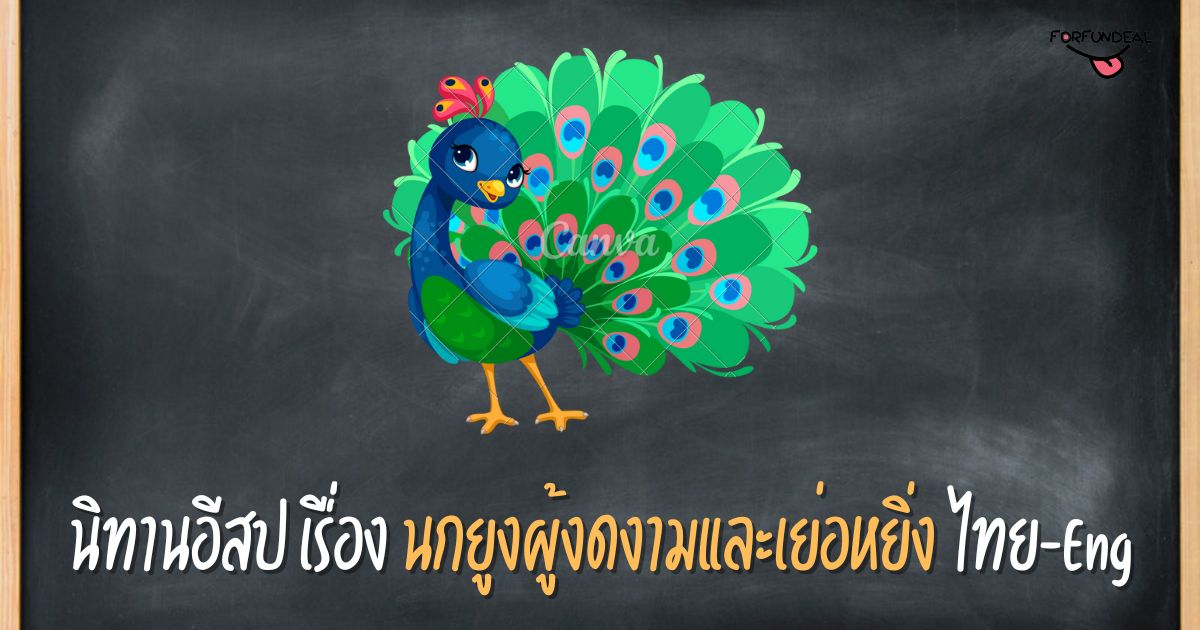“นกยูงผู้งดงามและเย่อหยิ่ง” เป็นนิทานอีสปที่สอนเราถึงการเข้าใจความงดงามที่แท้จริงไม่ได้มาจากภายนอกเสมอไป แต่มันยังอยู่ภายใน และยังสอนถึงความเห็นอกเห็นใจอีกด้วย
นิทานอีสปเรื่องนกยูงผู้งดงามและเย่อหยิ่ง
กาลครั้งนานมาแล้ว ในป่าเขียวขจีแห่งหนึ่ง มีนกยูงผู้เย่อหยิ่งและสง่างามอาศัยอยู่ ด้วยขนที่มีชีวิตชีวาและการวางมาดที่สง่างาม นกยูงจึงคิดว่าตัวเองเป็นสิ่งมีชีวิตที่สวยงามที่สุดในโลก มันมักจะอวดขนนกสีสันสดใสอวดสัตว์อื่นๆ ถึงความงามที่ไม่มีใครเทียบได้
Once upon time, In a lush forest, there lived a proud and majestic peacock. With its vibrant feathers and graceful strut, the peacock thought itself to be the most beautiful creature in the world. It would often flaunt its colorful plumage, boasting to other animals about its unmatched beauty.
วันหนึ่ง นกกระจอกผู้ถ่อมตัวสังเกตเห็นพฤติกรรมของนกยูงและเดินเข้าไปหาด้วยความอยากรู้อยากเห็น นกกระจอกถามว่า “นกยูง ทำไมเจ้าถึงภูมิใจในขนอันงดงามของเจ้า”
One day, a humble sparrow observed the peacock’s behavior and approached it with curiosity. The sparrow asked, “Peacock, why are you so proud of your magnificent feathers?”
นกยูงที่เต็มไปด้วยความภาคภูมิใจตอบ “นกกระจอกที่รัก แค่มองมาที่ข้าสิ ขนของข้าช่างงดงามจับใจจริงๆ ข้ามีความสุขจริงๆ กับของขวัญสุดพิเศษชิ้นนี้”
The peacock, full of pride, replied, “Dear sparrow, just look at me! My feathers are a mesmerizing display of beauty. I am truly blessed with this extraordinary gift.”
นกกระจอกแม้จะประทับใจในรูปลักษณ์ของนกยูง แต่ก็ถามว่า “นกยูงที่รัก ขนที่สวยงามของเจ้าทำให้ใจดี ฉลาด หรือเห็นอกเห็นใจด้วยไหม?”
The sparrow, although impressed by the peacock’s appearance, asked, “But, dear peacock, do your beautiful feathers make you kind, wise, or compassionate?”
นกยูงนิ่งเงียบโดยตระหนักว่าความงามภายนอกไม่จำเป็นต้องสะท้อนถึงคุณสมบัติภายในของมันเสมอไป มันเริ่มไตร่ตรองคำพูดของนกกระจอกและยอมรับว่าความเย่อหยิ่งของมันทำให้มันมองไม่เห็นถึงความสำคัญของลักษณะนิสัย
The peacock fell silent, realizing that its outer beauty did not necessarily reflect its inner qualities. It started to ponder the sparrow’s words and acknowledged that its pride had blinded it to the importance of character.
ตั้งแต่วันนั้นเป็นต้นมา นกยูงก็ตัดสินใจที่จะให้ความสำคัญกับการบ่มเพาะคุณสมบัติต่างๆ เช่น ความเมตตา สติปัญญา และความเห็นอกเห็นใจ แทนที่จะพึ่งพารูปลักษณ์ภายนอกเพียงอย่างเดียว มันได้เรียนรู้ว่าความงามที่แท้จริงนั้นนอกเหนือไปจากรูปลักษณ์ภายนอกและอยู่ในคุณธรรมที่กำหนดลักษณะนิสัยของคนๆ หนึ่ง
From that day on, the peacock decided to focus on cultivating qualities such as kindness, wisdom, and compassion rather than solely relying on its physical appearance. It learned that true beauty goes beyond outward appearances and lies in the virtues that define one’s character.

นิทานเรื่องนี้สอนให้รู้ว่า
“ความงามที่แท้จริงไม่ได้เป็นเพียงรูปลักษณ์ภายนอกเท่านั้น แต่อยู่ที่คุณธรรมของจิตใจและจิตใจด้วย”
- ความงามที่แท้จริงมาจากภายใน: เรื่องราวนี้เตือนเราว่าความงามที่แท้จริงไม่ได้ถูกกำหนดโดยคุณลักษณะทางกายภาพหรือรูปลักษณ์ภายนอกเท่านั้น สอนให้เราเห็นคุณค่าของคุณสมบัติภายใน เช่น ความกรุณา ปัญญา และความเห็นอกเห็นใจ ซึ่งเป็นเครื่องหมายของความงามที่แท้จริง
- อันตรายจากความเย่อหยิ่งจองหอง: ความเย่อหยิ่งในขนนกยูงมากเกินไปทำให้มองไม่เห็นถึงความสำคัญของอุปนิสัย เรื่องนี้เตือนเราเกี่ยวกับอันตรายของความเย่อหยิ่งและความจำเป็นที่จะต้องถ่อมตัวและเปิดรับการเติบโตส่วนบุคคล
- การปลูกฝังคุณธรรมภายใน: การตระหนักรู้ของนกยูงกระตุ้นให้เรามุ่งเน้นไปที่การปลูกฝังคุณธรรมและคุณสมบัติภายในที่เสริมสร้างลักษณะนิสัยของเรา ส่งเสริมเราให้ให้ความสำคัญกับความเมตตา ปัญญา ความเห็นอกเห็นใจ และความเห็นอกเห็นใจ ซึ่งนำไปสู่ความงามที่แท้จริงของเราและสร้างผลกระทบเชิงบวกต่อผู้อื่น
- ความสำคัญของการไตร่ตรองตนเอง: เรื่องราวเน้นความสำคัญของการไตร่ตรองตนเองและการใคร่ครวญ เมื่อตั้งคำถามกับความภาคภูมิใจของตัวเองและฟังมุมมองของนกกระจอก นกยูงก็เข้าใจตัวเองอย่างลึกซึ้งยิ่งขึ้นและเริ่มต้นการเดินทางเพื่อการเติบโตของตนเอง
- ความงามมีความหลากหลายและเป็นเรื่องส่วนตัว: เรื่องราวเน้นย้ำว่าความงามมีความหลากหลายและเป็นเรื่องส่วนตัว และไม่ควรจำกัดอยู่เพียงรูปแบบหรือรูปลักษณ์ใดรูปลักษณ์หนึ่ง แต่ละคนมีคุณสมบัติและคุณสมบัติที่เป็นเอกลักษณ์ของตนเองซึ่งทำให้พวกเขาสวยงามในแบบของตัวเอง
“True beauty is not just in appearance but in the virtues of the heart and mind.”
- True beauty comes from within: The story reminds us that true beauty is not solely defined by physical attributes or external appearance. It teaches us to value inner qualities such as kindness, wisdom, and compassion, which are the true markers of beauty.
- The dangers of excessive pride: The peacock’s excessive pride in its feathers blinded it to the importance of character. The story warns us about the dangers of arrogance and the need to remain humble and open to personal growth.
- Cultivating inner virtues: The peacock’s realization prompts us to focus on cultivating virtues and inner qualities that enrich our character. It encourages us to prioritize kindness, wisdom, empathy, and compassion, which contribute to our true beauty and make a positive impact on others.
- The importance of self-reflection: The story highlights the significance of self-reflection and introspection. By questioning its own pride and listening to the sparrow’s perspective, the peacock gained a deeper understanding of itself and embarked on a journey of personal growth.
- Beauty is diverse and subjective: The story underscores that beauty is diverse and subjective, and it should not be limited to one particular form or appearance. Each individual possesses their own unique qualities and attributes that make them beautiful in their own way.
โดยสรุปแล้วนิทานเรื่องนี้สอนให้เรารู้จักชื่นชมความงามในตนเองและผู้อื่น กระตุ้นให้เราให้ความสำคัญกับคุณธรรมภายใน รักษาความอ่อนน้อมถ่อมตน และเปิดรับความงามที่หลากหลายในโลก เราสามารถเปล่งความงามที่แท้จริงและสร้างผลกระทบเชิงบวกต่อคนรอบข้างได้ด้วยการมุ่งเน้นที่การปลูกฝังลักษณะนิสัยของเรา

